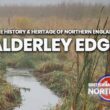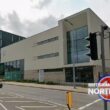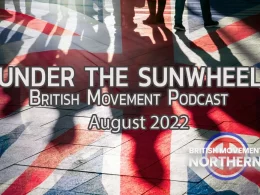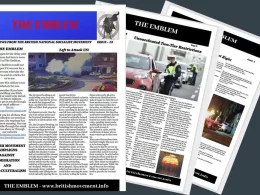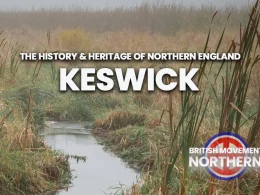As a break from the usual format of this series, this article looks at an entire region of the North-West of England, the Wirral peninsula, usually referred to as The Wirral.
The Wirral has a long history and within its limited geography encompasses a number of small towns and villages and exists in sharp contrast to its massive neighbour, the city of Liverpool.
The Wirral stands between the rivers Dee and Mersey, and faces out into Liverpool Bay and the Irish Sea, long considered as part of Cheshire and standing as independent as possible from the rest of Merseyside.
The Anglo-Saxons called the peninsula ‘On Wirhealum’ which was then taken into Old English as being ‘wirl’ meaning a bog myrtle bush or tree and ‘heal’ a slope or corner of land covered in bog myrtle. The low-lying land between two rivers being marshy and covered in bog myrtle.
By the 8th Century the Wirral was part of the Kingdom of Mercia and recorded as ‘the Hundred of Wirral’. Never heavily populated, the Wirral peninsula has a long history, and has seen human habitation and activity way back into ancient times.
There is evidence of settlements across the Wirral during the Middle Stone Age and later in the Neolithic period, when woodland was being felled and farming was beginning. Small settlements were established through the Bronze Age and into the Iron Age which became the first villages on the Wirral, of the Celtic tribe the Cornovii.
It was during the Bronze Age and across the Celtic period that the coastal village of Meols became a trading port, not only with other parts of Britain, but with Ireland and continental Europe.
When the Roman occupation of Britain began, the Romans took cover control of the Wirral peninsula apparently with the cooperation of the Cornovii tribe and the Romans quickly recognised the usefulness of the port at Meols. The Romans built a road from their regional headquarters at the city of Chester to link it to the trading port at Meols.
Towards the end of the Roman occupation of Britain, the spread of Christianity reached the Wirral and the earliest churches were built by Christian monks from North Wales. The early churches on the Wirral were all linked to the Celtic Welsh tradition rather than the Irish Church being established further north in Britain. The first churches being built at Landican, Overchurch, Woodchurch and at Bromborough.
The earliest church on the Wirral was probably at Landican, ‘Llan-tegan’ meaning the church of Saint Decan. An Anglo-Saxon runic stone, dated to around 800 AD stands in the grounds of the church at Overchurch.
However, when the Anglo-Saxons came to the area they were not yet fully converted to Christianity and there was considerable territorial conflict with the Welsh kingdoms along the very fluid border.
Between 613 and 616 AD, the Anglo-Saxon king Aethelfrith defeated the Powys Welsh at Chester and extended his control over all the land south of the River Mersey, taking the Wirral into the kingdom of Mercia.
The Wirral remained part of Mercia until the Danish/Viking wars of Alfred the Great and the partition of England under his peace treaty with Jarl Guthrum and the creation of the Danelaw. The Wirral formed part of the south-western area of the Danelaw, taken from the kingdom of Mercia by the Danish/Viking overlords and was frequently raided by warbands from Wales.
From the year 902 onwards, Hiberno-Norse vikings began settling on the Wirral as they were being driven out of their colonies in Ireland. These Norse settlers were linked into a network of Norse settlements all the way up the North-West coast as far as the Solway, and were connected directly to the Scandinavian rulers of York and Northumbria.
In 1086 the Norman overlords of England set their claim on the Wirral, the peninsula became part of the holdings of Earl Hugh of Chester. The Domesday Book listed more than 20 Saxon controlled estates and manors on the Wirral, the largest being at Eastham, now subservient to the Norman lord.
As in many areas of medieval England the Wirral was swept by the Black Death in the 14th and into the 15th Century and the population declined, recovery was slow and tax records of 1545 show that there were only 15 active parishes on the Wirral with a population total of just 4,000 people.
The Wirral remained as a region of low population until the late 17th Century and began to grow as trade and dockyards developed along both sides of the Mersey and the influence of the port of Liverpool expanded.
A quick snapshot of the history of some places on the Wirral
Wallasey takes its name from the Old English meaning ‘island of the Welsh’, meaning that the settlement pre-dated the Anglo-Saxon takeover and the population were Celtic Britons, referred to by the newcomers as ‘Welsh’.
Hoylake (originally Hoyle Lake) was a small port that grew up in the late medieval period as a rival to Meol. As did Neston and Parkgate, especially when silting up in the River Dee began to affect the moorings at Meol.
The increasing number of Wirral shore ferry stations along the Mersey in the 18th Century saw new developments like New Ferry (its name speaks for itself).
Birkenhead stands on a headland where the early church established a priory in the 11th Century, it was dedicated to Saint James and Saint Mary, expanded and protected by the Norman baron Hamo de Massey. In the 14th Century, the priory at Birkenhead was granted a royal charter by King Edward III to operate a ferry across the River Mersey to the northern shore. This is the origins of the modern-day Birkenhead ferry.
Birkenhead really began to grow during the Industrial Revolution in keeping with other Wirral villages and small towns along the Mersey such as Ellesmere Port and Port Sunlight.
Bromborough was a settlement where the early church was also established and is one of several locations in middle England to claim to be the location of the Battle of Brunanburgh in the year 937 when the Anglo-Saxon armies of King Athelstan defeated the alliance of Vikings, Northumbrians, Scots and Hiberno-Norse from Ireland.
New Brighton and Hoylake grew in size and importance as coastal ‘resorts’ during the 19th Century as more affluent families from Liverpool began to take holidays and sought days out. They also saw the creation of lifeboat stations during the same period.

Ever since the mid-19th Century, the Wirral has reflected sharp contrasts in population, some areas of the peninsula were financially affluent, while the rapidly expanding dockyards, shipyards and ferry ports had increasing pockets of poverty.
According to the current available population data, the population of The Wirral is 98.3% White, which puts the area into stark contrast with Liverpool City region just across the river.
Resources:
Bottom Image: Colmanian (talk) (Uploads), Public domain, via Wikimedia Commons/
The British Movement welcomes articles for possible inclusion on this site from members and supporters across the North of England. Please remember that we have to operate within the laws of this country – we will not include any content that is against the current laws of the United Kingdom. News reports should be topical and be relevant to the regions covered by this website.




